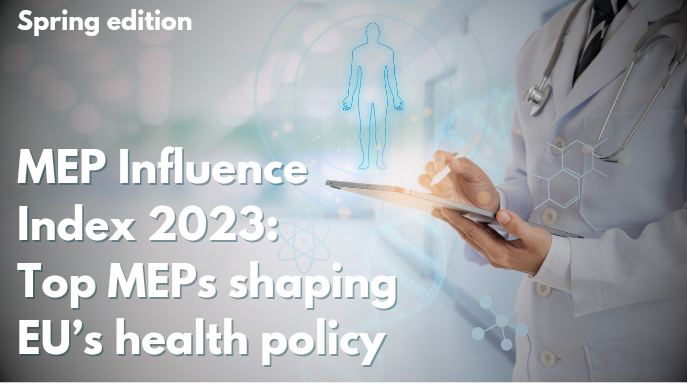Are you sure you want to perform this action?
Updates

MEP Influence Index 2023: Top MEPs shaping EU’s health policy
This analysis measures the influence that Members of the European Parliament are exerting over EU legislation and documents that shape health policy. It is part of a series of reports that includes:
MEP Influence Index overall (across all policy areas)
MEP Influence Index in Environmental policy
MEP Influence Index in Agri-food policy
MEP Influence Index in Digital policy
MEP Influence Index in International trade
MEP Influence Index in Social policy
This research measures MEPs’ influence through a combination of criteria clustered in the following categories: formal and informal leadership positions, actual legislative work, political network, committee membership and voting behaviour. To read the full methodology, click here.
NB: we will soon publish an assessment of the Commissioners’ performance and their chances of being re-elected. If you wish to contribute to this assessment, feel free to take our quick survey.
Key findings
-The top 5 most influential MEPs shaping health policy are: Véronique Trillet-Lenoir, Bartosz Arłukowicz, Joanna Kopcińska, Sara Cerdas and Tilly Metz.
-Differently from other topics such as the environment, MEPs from several CEE delegations (such as Croats, Poles and Slovenes) tend to be particularly active on this topic, especially if they have a medical background.
-The influence on health is concentrated in the largest groups, with the S&D members benefitting from solid network and voting performance, while EPP members are more strongly represented in leadership positions and Renew ones are most active on legislation.
More details on the above findings can be found below.
Important: when tracking influence over EU policies, always bear in mind that while individual MEPs are the visible signatories of initiatives or amendments, they are not operating in an information vacuum. Rather, their views and actions are shaped by bigger political and societal forces / pressures that surround them and that they are networking with.
To understand the full picture, you need to look at the strength of these forces and the direction in which they are pushing and pulling. For example, the chart below shows the level of influence of all MEPs on regulation on the health sector, but also the direction in which each of them is working to influence this policy area, e.g. whether they promote a more restrictive or a more liberalised regulatory framework. Particular attention should be paid to the MEPs who are in the middle, i.e. they have both a fair level of influence and moderate views, because in the current fragmented political landscape, these MEPs (swing voters) are the ones that make the difference, i.e. their votes are the ones that decide whether a key paragraph is approved or not.
Note: in the chart below, only the names of top MEPs are revealed. To uncover the full picture, contact us at [email protected].
NB: We expect a significant turnover in the composition of the European Parliament after the 2024 elections. According to our latest calculations, only 42% of the current cohort of MEPs will be re-elected next year, although the chances of the top MEPs to make it are higher (but only slightly). Contact us at [email protected] to get timely predictions and updates on the future composition of the European parliament, including the likely new MEPs and their backgrounds.
Trends by national groups
Differently from other topics such as the environment, MEPs from several CEE delegations tend to punch above their weight when it comes to health topics, which might be due to a higher number of their MEPs having a medical background. Croats, Poles and Slovenes are among the national groups that are particularly active on this topic. While 2 Polish MEPs are featured in the top 5 (Arłukowicz and Kopcińska), Croats (especially Sokol and Borzan) and Slovenes (especially Joveva) are not too far behind.
Conversely, despite a few names which stand out, French and Germans are not among the most active on health.
Trends by political groups
The picture on influence by political groups is generally balanced, with the members of the largest groups being more effective on this topic compared to those belonging to the smaller groups. While S&D members are particularly strong with regards to their network and voting performance, EPP members tend to be more strongly represented in leadership positions, whereas Renew members are the top performers with regards to legislative activities.
This even balance of power on health raises questions about the outcome of the recently presented pharmaceutical package, as the main political groups do not see eye to eye on several provisions (especially IPRs).
Would you like to find out who are the MEPs with moderate views that are most likely to make or break majorities in the current European Parliament or after the next elections? Feel free to contact us at [email protected] for more information on our data-driven services.
